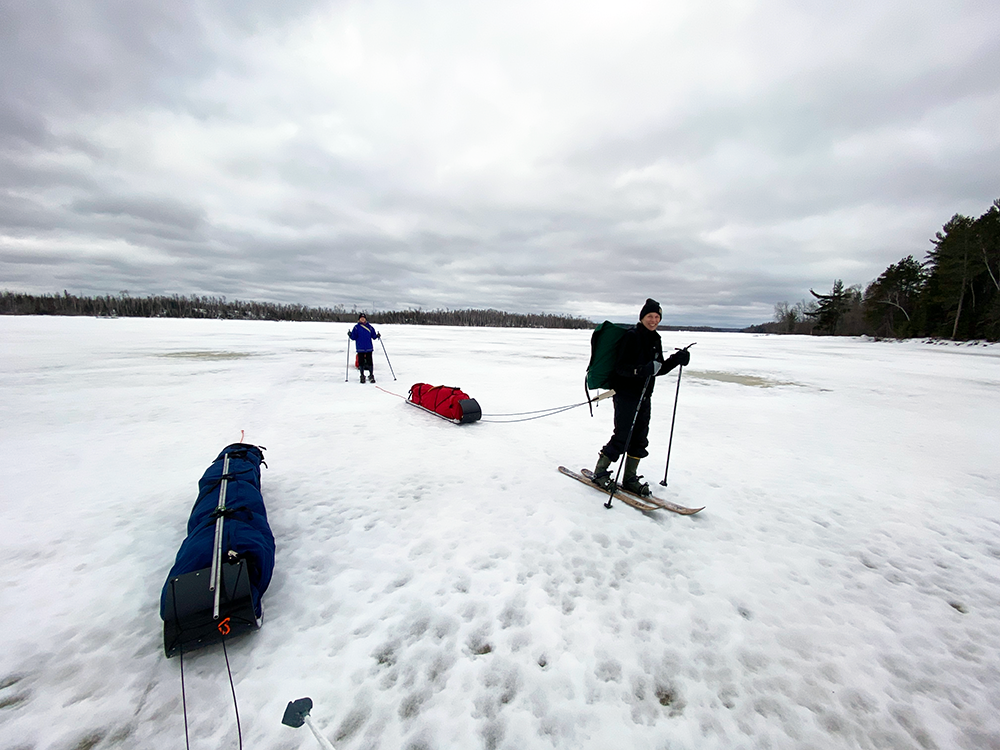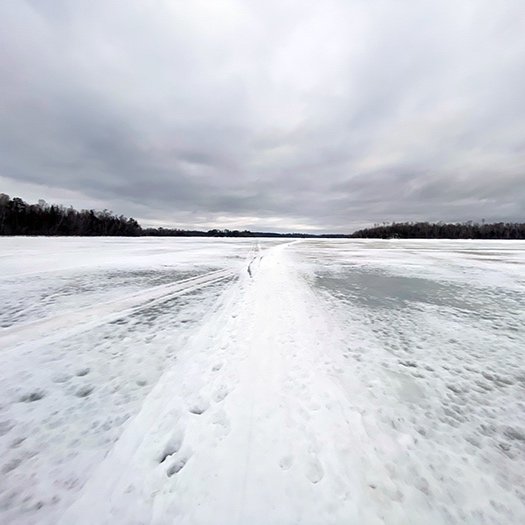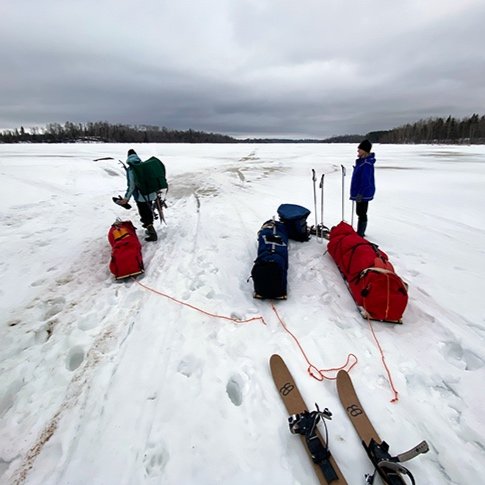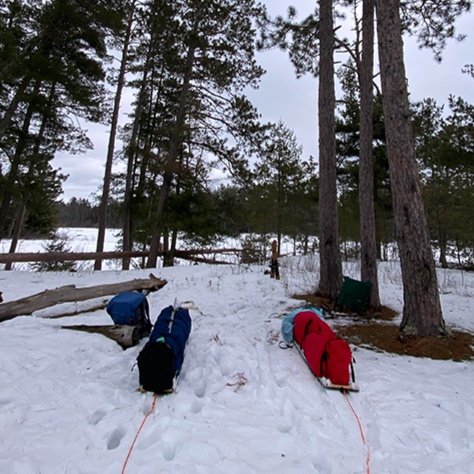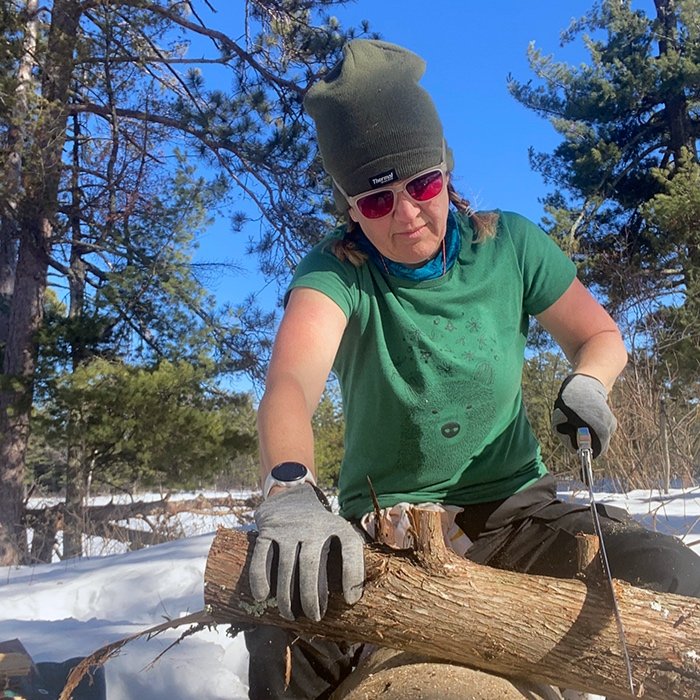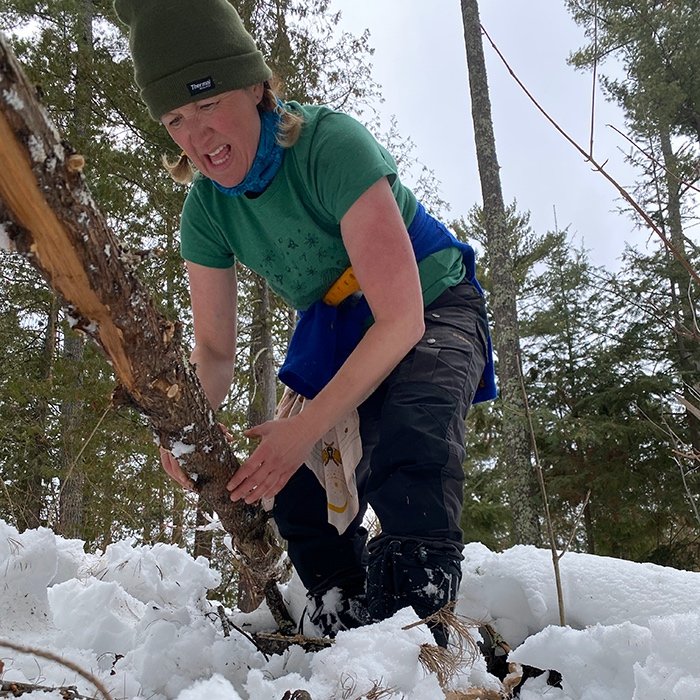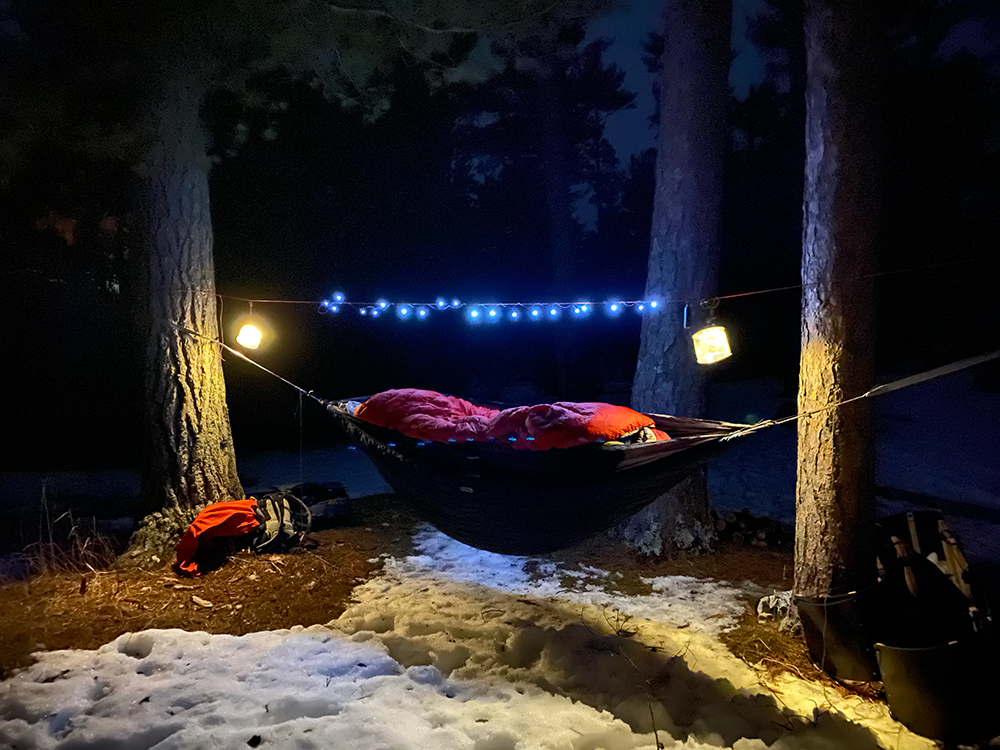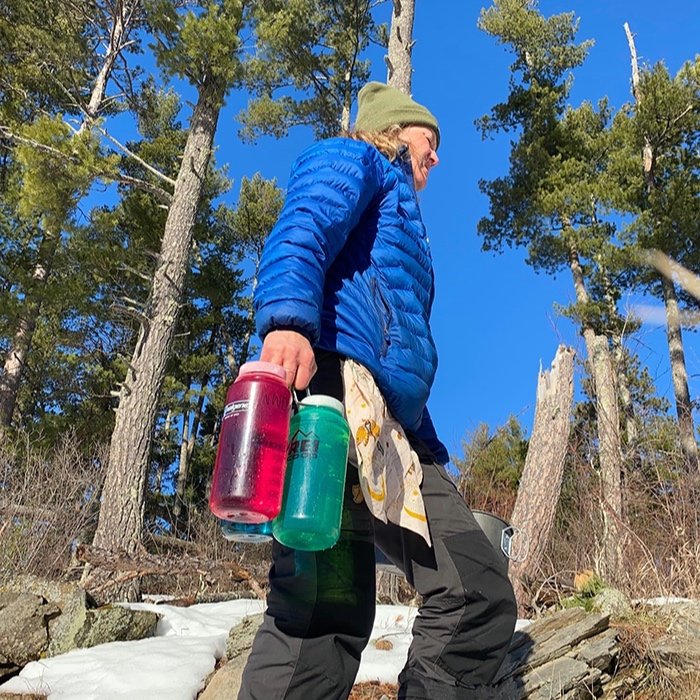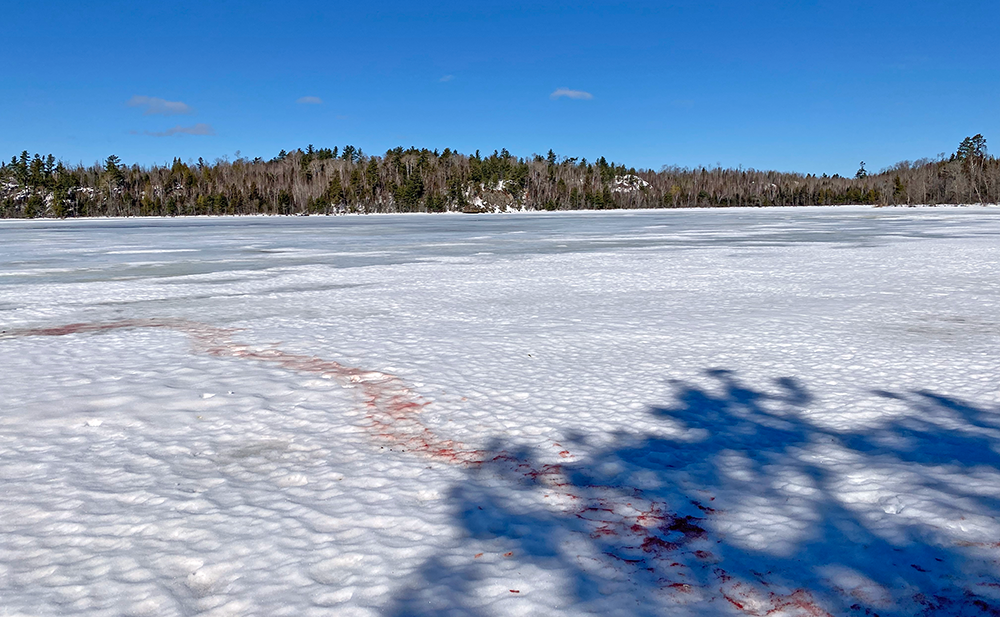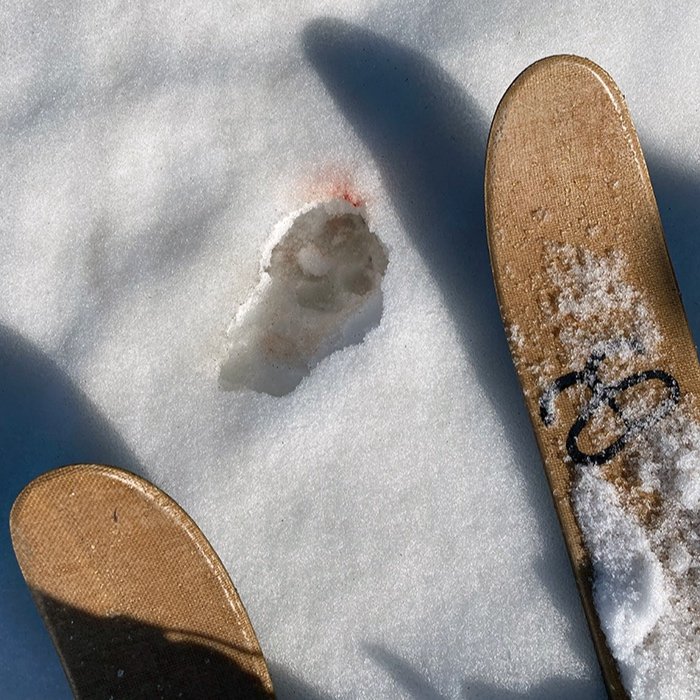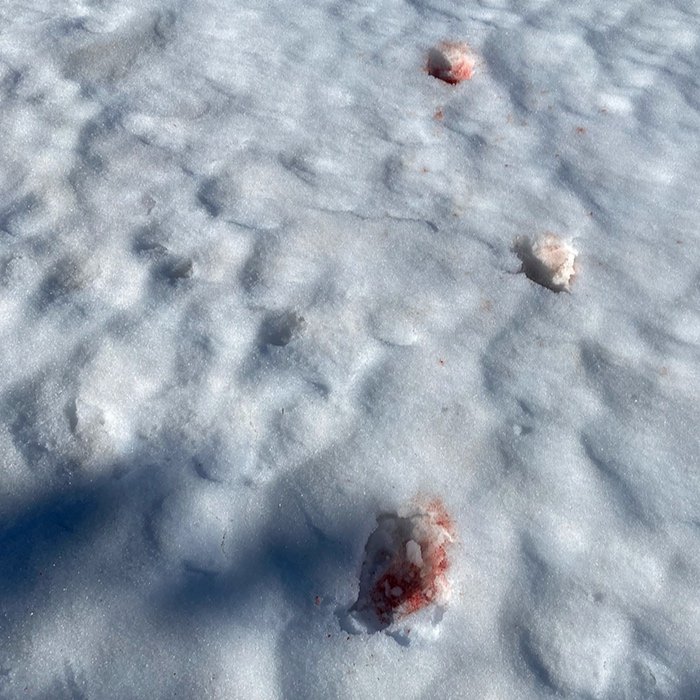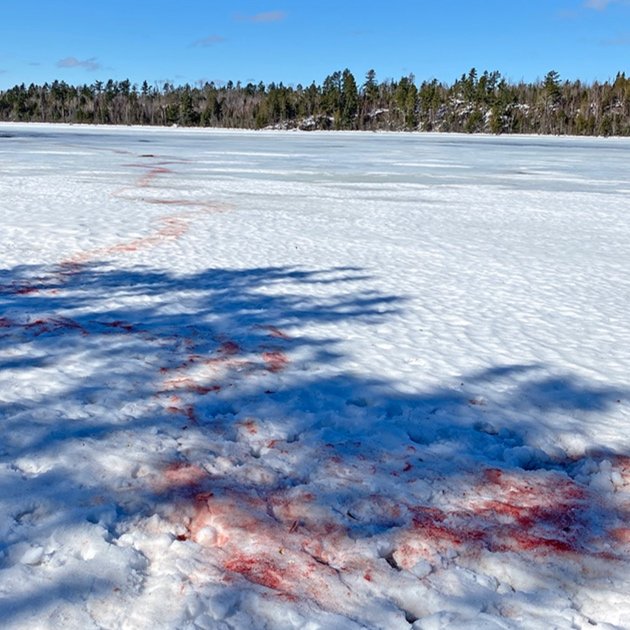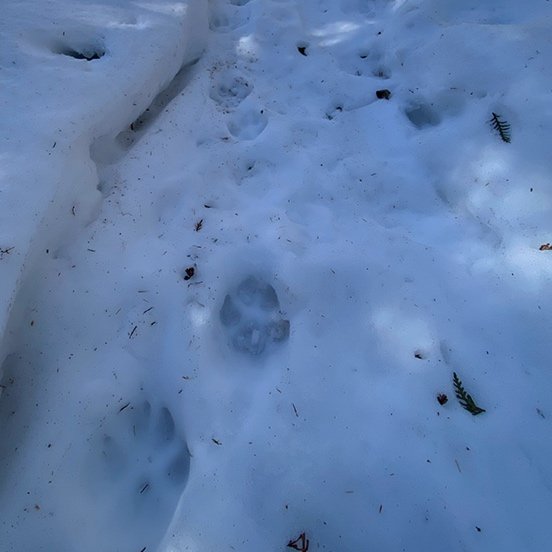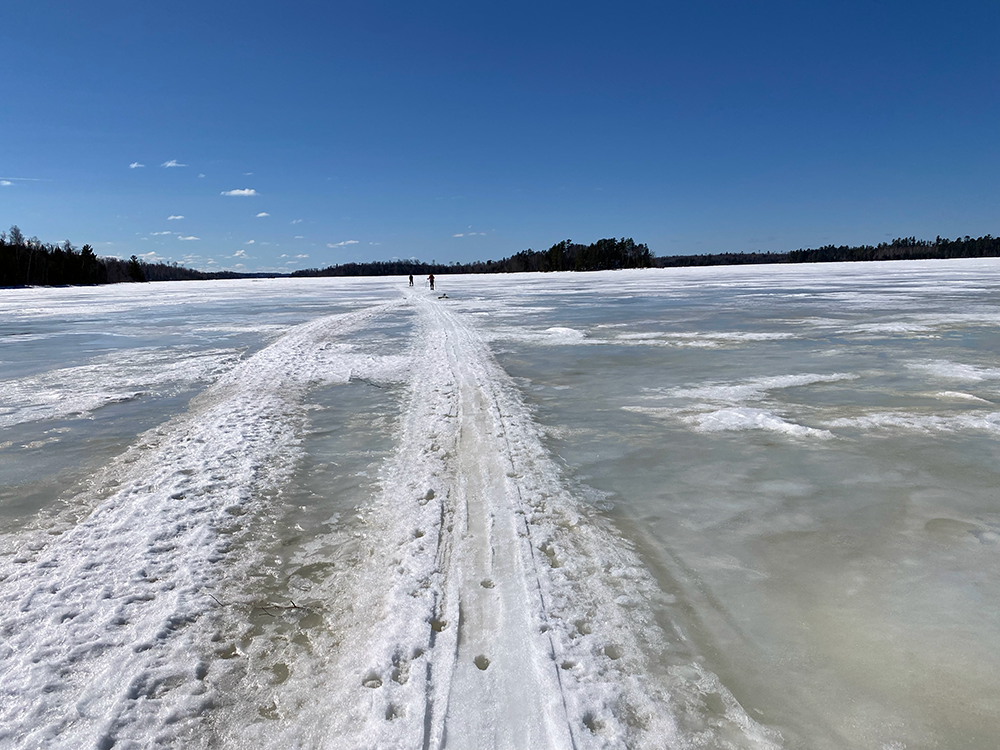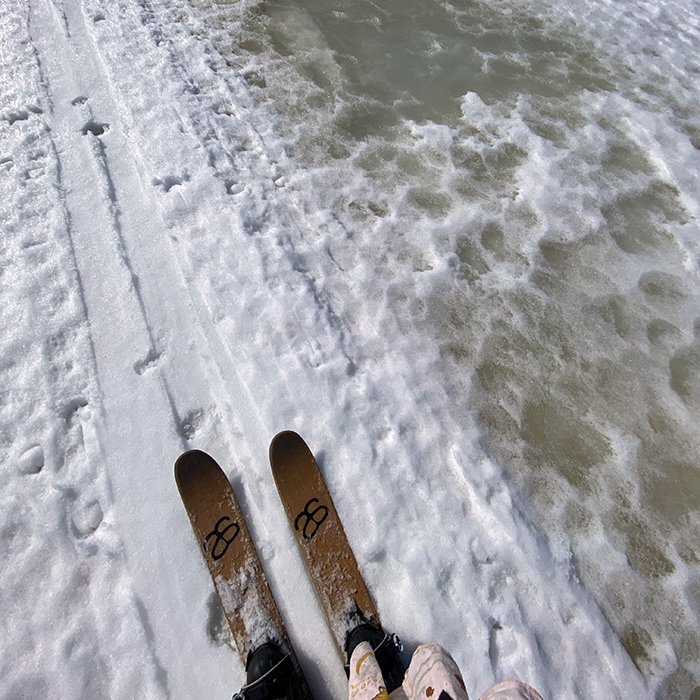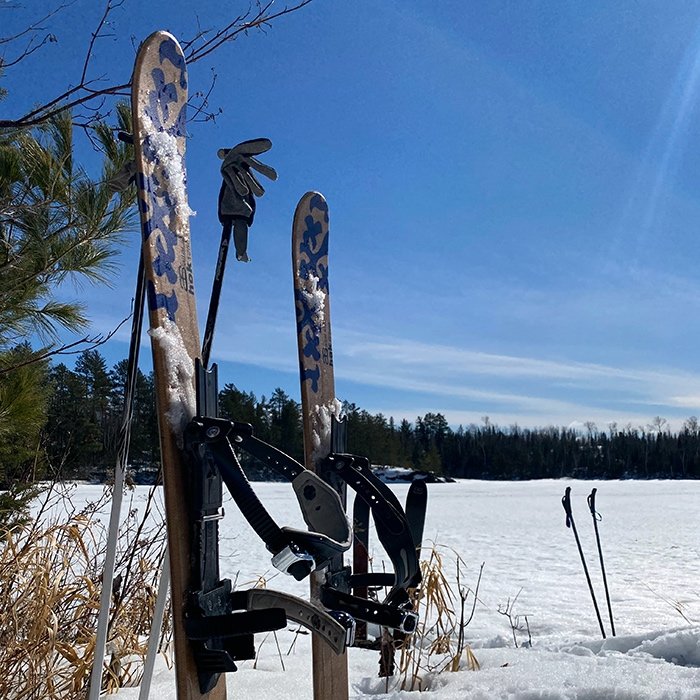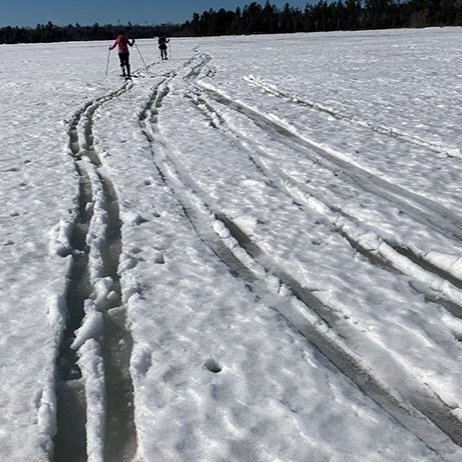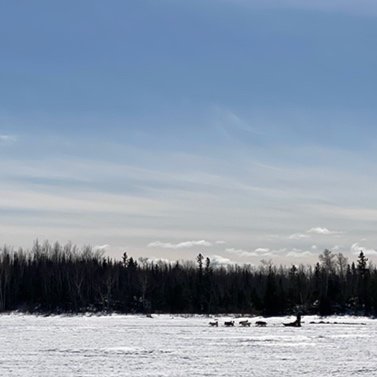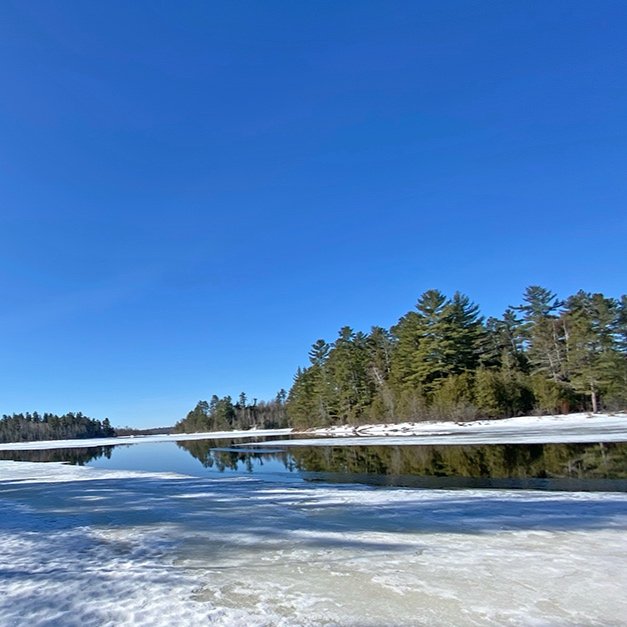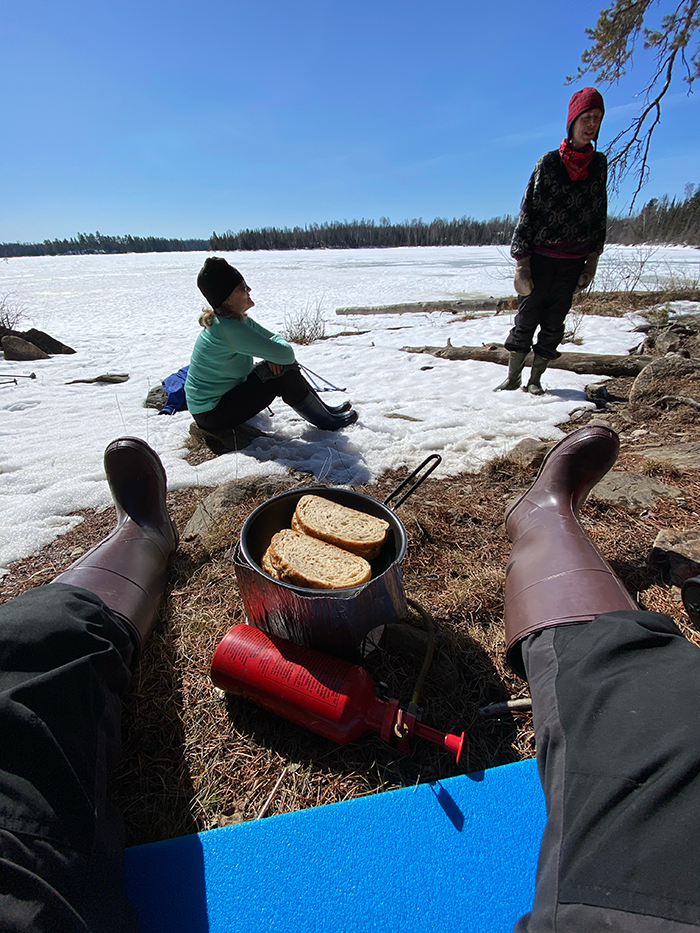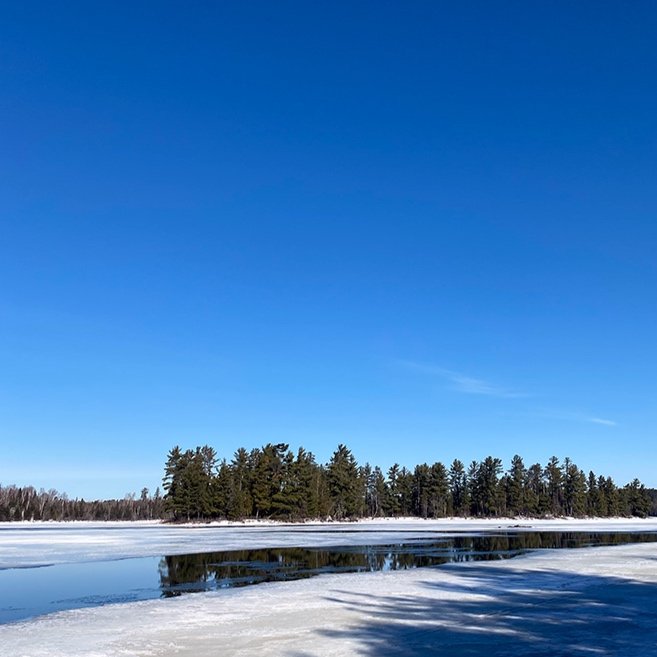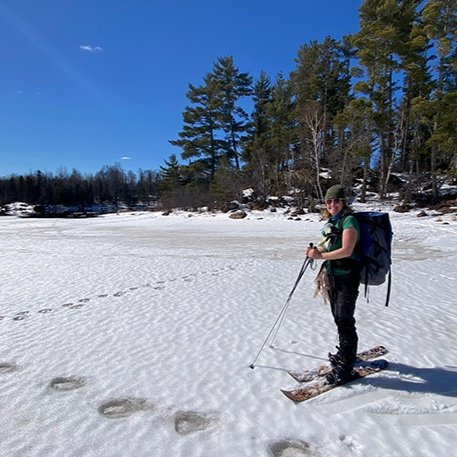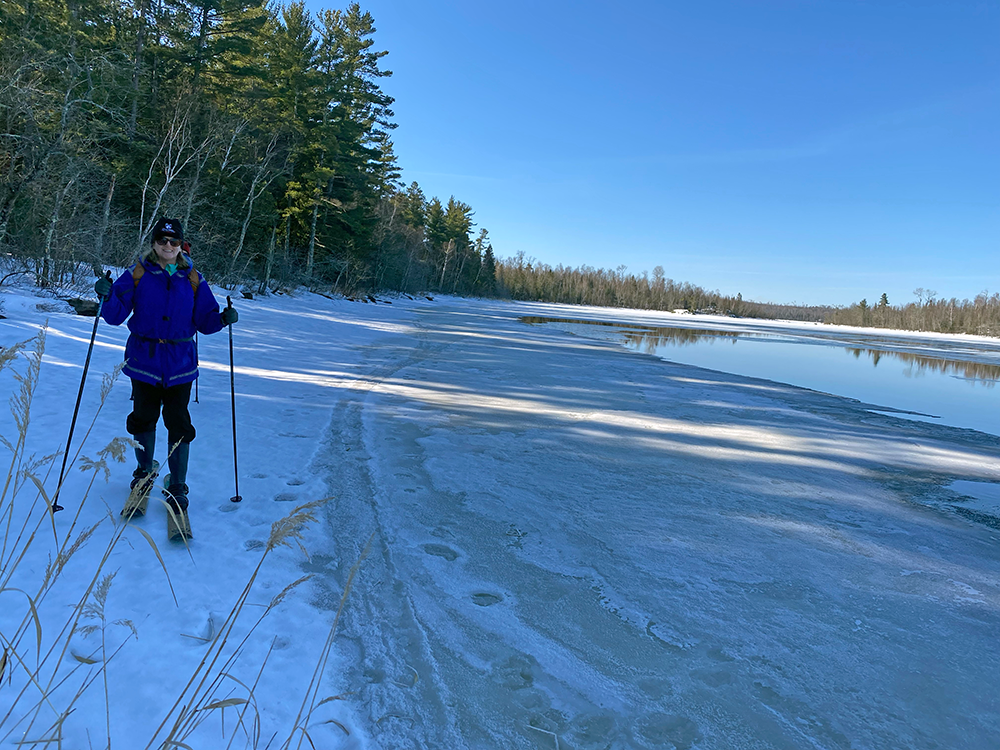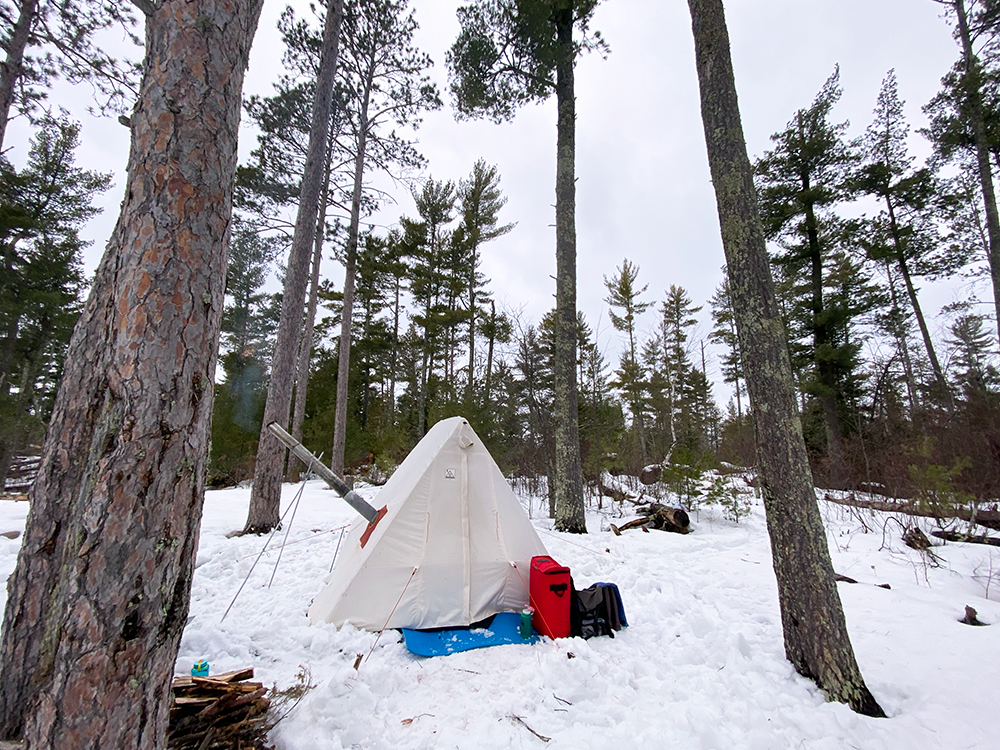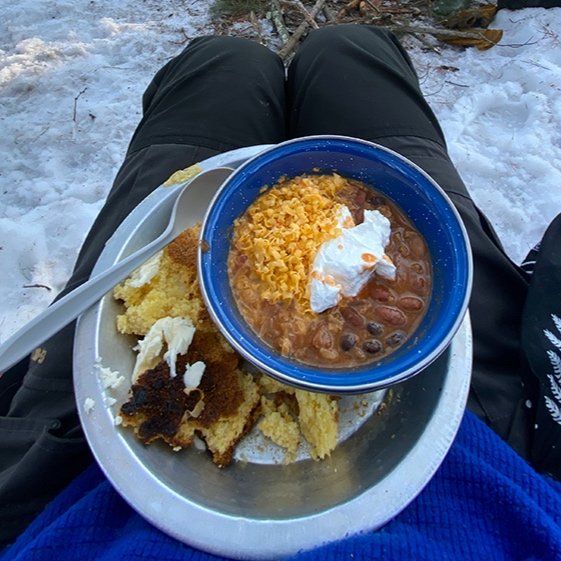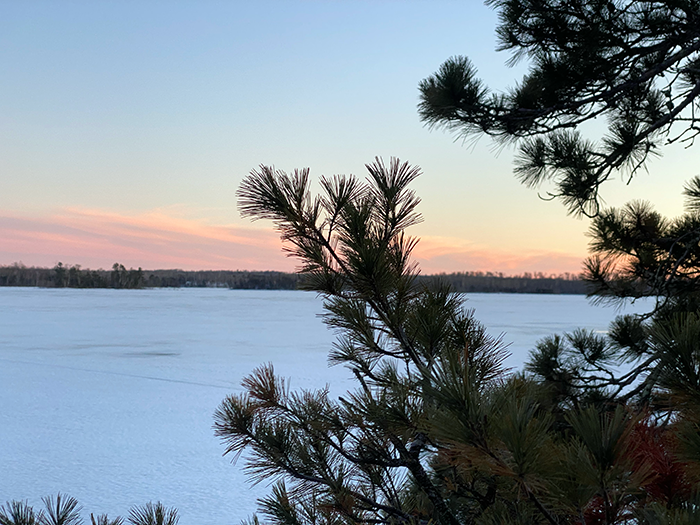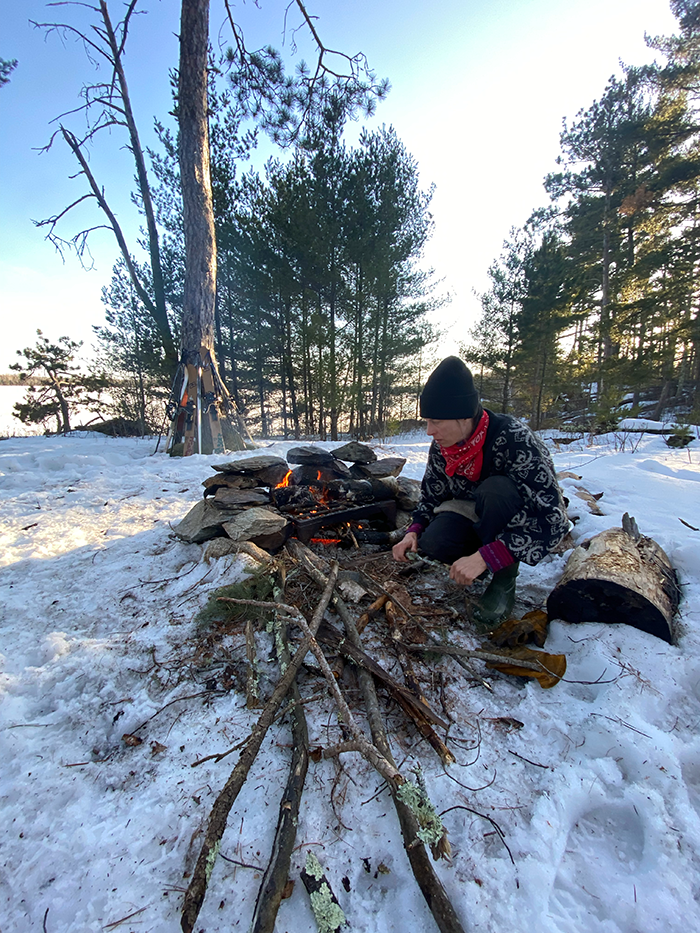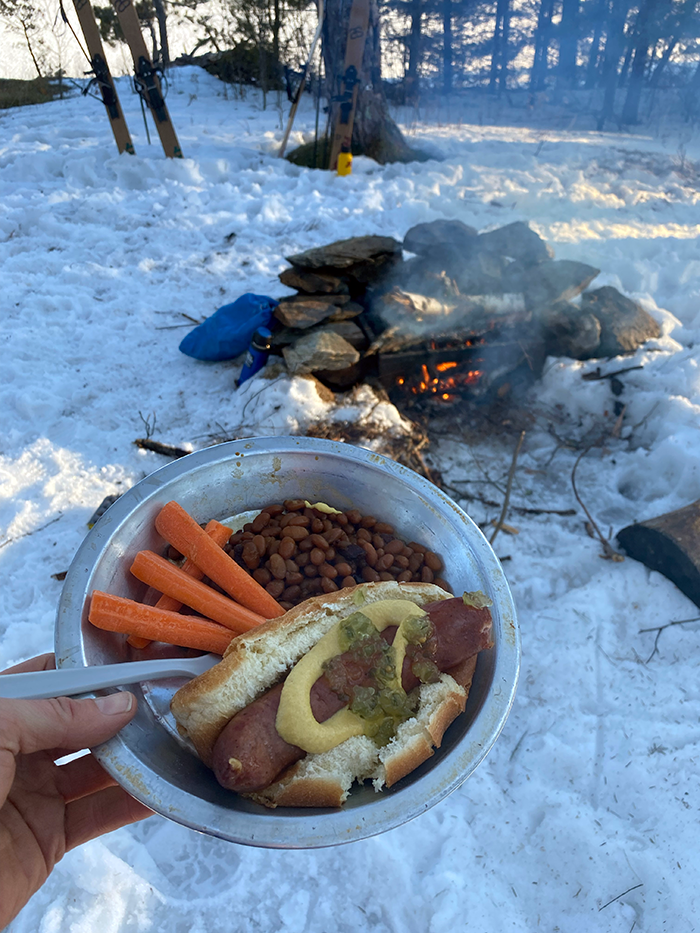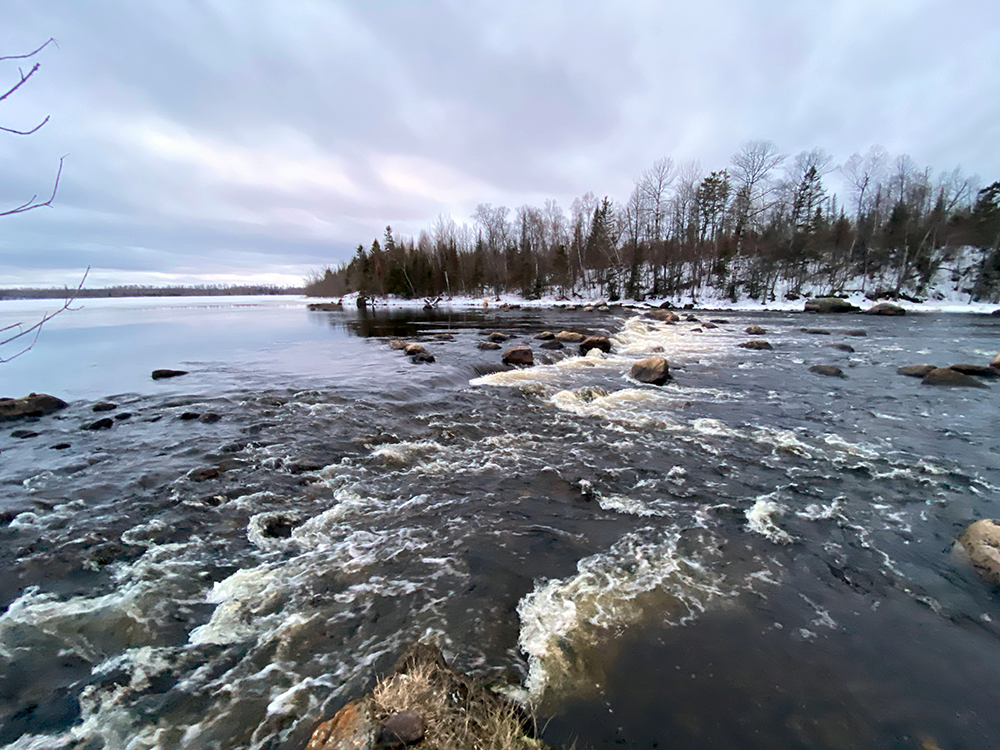A Guide’s Life | BWCA Early Spring Adventure
I skied along, more in slush than on snow. The temperatures were warming to the mid-40’s and the top layer on the lake was in a hurry to melt. Two women followed behind, pulling sleds as we headed toward a remote wilderness campsite in the Boundary Waters Canoe Area Wilderness in Northern Minnesota.
This was my final winter guiding trip for the season and I was trusting reports that the ice was still thick enough on the lakes for travel. Outside of deep pockets of slush we kept punching through, it appeared solid underneath. However, it was hard to tell how solid.
We headed a couple of miles northeast on Fall Lake, to a campsite that sits on a pinch point between the large lake and the river like flowage of Newton Lake. I’d heard there was a really scenic cascade here and I’d hope we’d get up into some lovely, secluded country to the north, near the Canadian border. Travel due to ice conditions was really slow going so it wasn’t worth trying to fight the slush for miles.
Rounding a point close to the cascade, I could hear water flowing freely, but the campsite was still socked in by ice. It was surrounded by large red pines and had beautiful views to the south/southwest. Knowing we’d fall asleep to the sound of falling water made my heart sing. Outside of gentle winds in the pines, it doesn’t get much better.
In the summer, this campsite would fit quite a crew. I suspect it gets a bit of traffic, being so close to the entry point of our trip as well as a nearby portage trail. In the winter. But it’s just us, and a couple of times we see a few locals out skiing.
Thanks to an early start, we’ve gotten to the site before lunch, giving us plenty of time to set up camp. While the others work on digging out a spot for the tent, I take a sled and go begin searching for wood. Because we’ll be here nearly four days, we’ll need a good pile of it. There has been conversations about eating around the campfire too!
I wander well away from camp knowing that the immediate area around it will be pretty picked over. The snow is 2.5’ deep off the portage trail and I use my Altai HOK skis to access logs. After I bring a load back, I pause and help set up the tent, assemble the stove and provide direction for putting down tarps and bedding. Once the bedroom in the. back of the tent is set, I go to work on setting up the kitchen, trying to keep everything organized and within arms reach.
Wood collection and production continues by the group. Once the trees are limbed with the hatchet, we use a pruning saw to saw them in lengths that will fit the wood stove. Another person takes the logs and splits them with our axe. Finally, we each take armfuls of logs to stack neatly near the tent. An armful go into the tent to further encourage drying. They say chopping wood warms you twice, well for us, it warmed us five times! Two things that feel precious winter camping - water and wood.
Chopping a hole in the ice becomes an easy chore due to the warming conditions. Pails and bottles of water are filled and pots of water put on the stove to boil for drinkability.
A couple of hours later, the others take a break, exploring the nearby falls. I take a few minutes to set up my hammock as I’ll be sleeping outside. As trees are plentiful, I choose a site with great views of the lake, hoping for some starry nights. I’ve brought a small, collapsible chair, and quickly becomes one of my favorite pieces of gear for winter camping. It’s so nice to have something to lean my back against, pile gear on and move around camp.
As the light begins to fade, I work on a dinner of curried chicken and vegetables knowing our appetites have been stirred. Because the temperatures are so mild, I don’t light the stove until after dinner. During the day, we’re all wearing one or two layers depending on how active we are.
Spring is clearly on the way as we have two trumpeter swans in the open bay near camp. We’ve seen numerous wolf, deer and snowshoe hare tracks. There’s been plenty of chattering echoing through the woods from ravens and squirrels who must be busy getting ready for babies. The animals are on the move and I hope we see them.
Sunshine hits my face the next morning. Sleeping in the hammock has been toasty and comfortable, though I don’t get much sleep. At 6:30am, I slip into the tent and open the stove. Grabbing a handful of shredded birch and a “nest” of twigs, I light one edge, watching the flame grow hold as I slowly add more small sticks. Eventually there will be enough embers to support larger logs. Nobody stirs. Breakfast today is scrambled egg hash with veggies.
During breakfast I suggest we head north up the portage, checking out Newton Lake to see how far we can go. Everyone agrees and packs for a day of exploring. The canoe pack is filled with lunch, emergency supplies and a pad for sitting on at lunch.
The portage is easy going and we quickly come to the end. Seeing a wide swath of open water to our west and knowing that these next miles have a current, we pick a trail across the ice that others have left.
The ice feels solid and we move along the edges of the shoreline. I stop and check ice thickness with the ski pole now and then. So far, really everything seems pretty good.
We go about a half mile further when I notice a red streak across the ice, ending near the open water. At first I can’t tell what it is. Upon closer inspection it’s the site of a fresh wolf kill. Bloody paw prints are everywhere along with the remainders of a deer leg. Looking at the evidence, we think that the wolves chased the deer onto the ice, making it more vulnerable to an attack there. Habits of the wood folk are always interesting to read.
We debate about going further. It’s obvious there are some open waterways to the north. If this were a personal trip, I’d take the risk, follow the shoreline and keep going cautiously, but with clients, I’m not as comfortable with it. So, we decide to head back the way we came, crossing the portage and following Fall Lake north. We have plenty of day light to do some of the Four Mile Portage at the north end of the lake if we want to. The going is slow as it’s now mid-morning and the conditions are wet and slushy. Personally, I find it more interesting going along the shores of smaller bodies of water versus the big, open lake. But we know the big lake is safer.
Rounding an island we spot a musher with about eight dogs coming down the marked musher trail. They seem to be out for a day trip. It’s fun to stop and watch them glide along, clearly happy, panting and enjoying this warm day as well.
When we get to the portage, we find a sunny spot of snow to pack down and enjoy some lunch at. The wilderness is quiet save for a gentle breeze. We can feel heat on our faces and I continue to travel the day in a tee shirt. Due to the poor travel conditions, the women prefer to head back to camp. A beautiful, full, day that is topped with a dinner of moose gravy, mashed potatoes and beans.
While brushing teeth outside in that evening, one person whispers, “look over by the bay - what are those?” The rest of us pop out of the tent to see three gray wolves circling and checking out a nearby beaver lodge. One pauses on top to sniff it. We stand in wonder as we watch them run across the ice, stopping briefly to check us out. Earlier we saw a deer moving through the same area and we ponder if they’re hot on it’s trail.
The temps dip slightly that night to 17º and I still feel a bit too warm in the hammock. Peeling off layers I find a better temp and look at the stars overhead, trying to identify constellations. Later, the moon moves quietly across the lake, casting beams onto my face.
The next morning I see another wolf moving across the ice. Clearly the animals take the paths of least resistance when they can. We see animal tracks all over the ice. Later in our trip another wolf will be spotted over the lake. Maybe it’s the same one.
Today is cooler and so we opt to explore Newton Lake and points north again. We hope we can skirt the edges of the ice and make it to one of the two campsites a few miles north for lunch. This stretch of lake is gorgeous - classic BWCA beauty on a river like system.. Dotted with islands packed with big white pines, we spy an active eagles nest with eagles sitting on it. The trumpeter swans have chosen another pocket of water for grooming their feathers this morning. Being close to shore allows us an intimate view of a landscape covered with grasses, granite outcrops dotted with lichen, brilliant red river birch, beaver lodges and tamarack bogs. It’s a landscape in high relief.
The ice feels even better than the day before and more of it is socked in. In a few spots we go overland, avoiding questionable areas. The first campsite is fine, but faces west and is deep with snow. We head a half mile further to the second site. It ends up being a gorgeous site near a pinch point of open water. Jackpine and spruce scent the air as we pick a southern facing exposure for lunch. I set out a large pad for everyone to sit and and go to work making hearty grilled cheese sandwiches and tomato basil soup. I’ve carried along a portable stove and some fuel and it’s definitely been worth the weight. We enjoy the strengthening sun, happy to be in this pocket of the wilderness alone.
After a leisurely rest, we reluctantly head back the way we came. While the snow is a bit stickier, its not too bad. We make it back to camp and change out our wet boots and gear. I’ve decided that I won’t be skiing in rain boots on future trips. I much prefer my Baffin boots as they are moderately waterproof with interchangeable liners. Hot spots on my feet are no fun.
While I work on a light dinner, the others stoke up the outside fire pit. For our last night we enjoy a classic meal of brats and beans. Later, the stash of chocolate is pulled out to top off our growing appetites.
I settle into a final night under the stars, listening to the sound of the ice moaning, cracking and shifting with the warming temps. I think those sounds are ok. I don’t really know and worry a little.
The others are awake a bit longer and eventually I hear them adding a couple of logs to the wood stove. After a few minutes, I can tell they’re having trouble by all the commentary and clanging around. Someone throws open the tent and I see a cloud of smoke billowing from it. Maybe they’ve packed it too tight? Maybe someone grabbed some damp wood? Maybe too much tinder was added and there’s no airflow?
I’m not sure, but it’s not getting better and so I peel the sleeping bag from my body, throw on my boots and go have a look-see. I’m not sure how they can stand it. The tent is thick with enough smoke to smoke a fish. I take a look and begin to troubleshoot. There doesn’t seem to be an obvious problem as the damper and air intake are open. The wood that was added seems mostly snuffed out by ash. The stove isn’t packed though. Did the wind shift and now we’re getting a down draft? I poke around inside the stove and try to relight it. I doesn’t want to start. The wind doesn’t seem to be the issue either.
I head outside and check the pipe. I gently knock on it in case there’s been some buildup. Then, thinking it might be the spark arrester, I pull it off. It’s partially plugged with soot and is the likely culprit. I knock the soot off and head back inside. Shoveling out the remaining ash and few remnants of wood, I restart the fire without issues. Everyone heads to bead getting toasty. Usually I stoke the wood stove before bed and it slowly goes out over a few hours. By then, everyone is asleep and comfortably warm. Being that it was reasonably warm outside, I didn’t stoke it much, figuring everyone was headed to bed. Ha! Next time I will check the arrester more frequently.
Tomorrow is our last day and we plan on getting onto the ice by 9am because we’ve learned it rapidly deteriorates after 11am. After a fitful sleep, I’m up at five. On the last day of a guided trip, I get up early and pack my stuff up first, as things get busy once I rouse the others. The stove is fussy this morning as the tinder and kindling was mostly used up. I give up pretty quick, knowing we just need hot something in our bellies and start the stove.
It takes us about two hours to pack up camp, which is pretty average. It takes a bit of work to release the tent skirt from it’s ice casing, but eventually it gives. The kitchen gear gets one final wipe down and is stored in crates that will protect everything from bumpy rides. The food pack is nearly empty and takes some loose gear. The sleds are slow to pack as everything exposed was coated in frost and nothing really wants to fold or bend. But eventually we make it work and once skis are strapped someone asks “what time is it"?”. I look at my watch, it’s 9am. Right on time!
We head out over wonderfully hard but crusty ice. We’re all glad that the slush is at bay for now. The sun is coming over the trees and it’s expected to be 50º today. I am wearing my boots as a strap fell off my skis while carrying them down to the lake. I actually prefer traveling on foot today as I don’t have to balance skis over the small ridges of ice covering most of the lake. I suggest traveling by foot to the others, but they’re content with leaving their skis on. We make very good time and are back to the entry point parking lot under two hours.
I’m feeling a growing fondness for winter camping and travel. It’s a ton of work - especially guiding, but I really love experiencing the wilderness in the winter. There is so much seclusion and you don’t have to go very far to find it. During the summers I’d avoid some of these areas due to the heavy traffic and challenges of grabbing a campsite. Winter releases all that pressure. I’m also learning that early spring trips and be great if you have milder temps. The lake travel is more challenging, but hanging in camp in a tee shirt is hard to beat.
I’m learning more about how to read ice conditions on lakes and river ways. I continue to refine how I pack gear, plan activities and prepare food. All elements that make winter camping really enjoyable and comfortable.
But the work’s not quite done. While the outfitter I work for will take care of the gear we’ve used, our personal gear storage area looks like an organized disaster. Is that even a thing? Going from trip to trip means some things get put on hold. Every piece of clothing and gear is getting cleaned. It will get inspected in case it needs to be repaired or replaced. Then, it will all get tucked away, ready for another trip.
Another winter guiding season, coming to a close.
RESOURCES
Google map of our route that includes points of interest and day trips.
Great Ely outfitter for guided trips, specializing in women-specific adventures. Full disclosure, this is the outfitter I guide for.
Black river sleds make great toboggans of all lengths.
My recommendation for backcountry skis for winter camping. They fit most winter boots.
Want to plan your own winter camping trip? Check out our handy guide that tells you how to begin. You will need to grab a permit at one of the entry point, trailhead kiosks.
Plan on fishing? Pick up a fishing license through the MN DNR.
Disclaimer: I do not receive any compensation from the resources mentioned in this article. If you want to go on your own winter camping trip, it’s up to you to plan and prepare for all the conditions you may encounter. Honestly assess your experiences, fitness and skill set. The BWCA is remote wilderness area and help may be hours or a day away. Conditions change frequently. Check with local outfitters and ranger stations for current updates.


